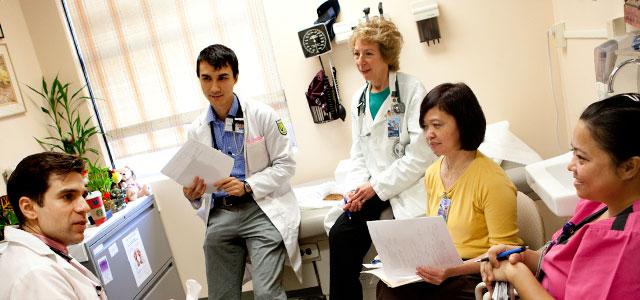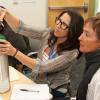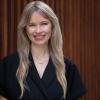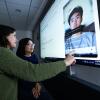
From left: nurse practitioner student Jonathan Van Nuys, medical resident Michael Wongchaowart, nurse practitioner preceptor Kristin Weaver, RN Leonides Penaflo and LVN Marbing Medina (photos by Elisabeth Fall).
Training Nurse Practitioners and Physicians for the Next Generation of Primary Care
It’s just before 8 a.m. in a cramped exam room at the San Francisco VA Medical Center’s primary care clinic. Nurse practitioner (NP) student Jonathan Van Nuys – a lean, kind-faced man in shirt and tie and white lab coat – is handing out pastries to celebrate his birthday; he’s surrounded by his nurse practitioner preceptor, a second-year medical resident, an RN and an LVN. After a few short minutes of eating and small talk, the group settles into a discussion of the day’s appointments.
Van Nuys is concerned about a patient who suffers from a spinal deformity and is showing signs of being suicidal; another patient struggles with alcoholism. Over the next 15 minutes the team discusses a number of similarly complex patients, each time arriving at a plan for the day’s appointment and follow-up care.
But this morning’s “huddle” is about more than planning the day. For one, it aims to foster better communication and closer care coordination among a team of professionals responsible for maintaining and improving the health of about 1,200 patients. At the VA, the team concept is known as PACT, which stands for Patient Aligned Care Teams. Numerous private entities – with incentives from the Centers for Medicare & Medicaid Services (CMS) and the Affordable Care Act (ACA) – are implementing a similar concept and calling it a “patient-centered medical home (PCMH).”
A second purpose is to advance an innovative experiment in the training of primary care providers at a time when it’s crucial to fill the pipeline. The San Francisco VA’s training program gives second-year NP students their own longitudinal panel of patients, trains the NPs alongside second-year medical residents and gives staff NPs dedicated precepting time – all three concepts virtually unheard of outside the VA.
“The VA recognized that the future is team-based care and that in order to perform effectively as a team, students need to learn on a team,” says NP Susan Janson, a faculty member at UCSF School of Nursing and co-director of the program.
“The literature suggests and we believe that patient care improves when the primary care team learns how to communicate, understands each others’ roles and utilizes team members effectively,” says physician and co-director Rebecca Shunk, who is on the faculty at UCSF School of Medicine.
“This rarely happens in other parts of the country and because physicians and nurse practitioners are trained separately – because, in particular, physicians don’t always know what nurse practitioners can do – they're not always an effective team. In the VA scenario, where people work side by side, they know,” says Susan Hassmiller, senior adviser for nursing at the Robert Wood Johnson Foundation (RWJF).
To help spur the effort, RWJF recently joined three companion organizations – the Josiah Macy Jr. Foundation, the John A. Hartford Foundation and the Gordon and Betty Moore Foundation – and the Health Resources and Services Administration to fund The National Coordinating Center for Interprofessional Education and Collaborative Practice at the University of Minnesota. At UCSF, School of Nursing faculty member Scott Reeves – a world-renowned British social scientist – directs the Center for Innovation in Interprofessional Education, which has participation from all four schools at UCSF: dentistry, medicine, nursing and pharmacy.
How the Program Works
For a full year, at the SFVA’s three local primary care clinics (two in San Francisco and one in San Bruno), an NP student and two residents have their own primary care patients and share the entire panel, to ensure greater continuity of care while receiving guidance from both physician and NP preceptors. The NP student is the continuous clinical presence, while the residents alternate every two months between inpatient and outpatient care.
Known as EdPACT (for Education in Patient Aligned Care Teams) and now in its second year, the educational program is a collaboration among the VA, the UCSF schools of medicine and nursing and the UCSF Office of Graduate Medical Education. Janson and Shunk run the program along with a team of experts in evaluation, communication, clinical care and quality improvement. In 2012, the team applied and was selected as one of only five VAs nationwide to receive a five-year, $5 million grant as a designated Center of Excellence in Primary Care Education.
In the program’s first year, seven NP students participated, even as they continued with their full academic load. This year there are nine NP students. In addition, the Center secured funding for NP fellowships that enabled three of last year’s students – now newly minted NPs – to continue their work and training at the VA.
An Ongoing Process of Program Creation
“Our starting point was trying to understand how people learn and improve practice in the context of a team,” says Bridget O’Brien of the UCSF Office of Medical Education, who along with Shunk and Janson took the lead in designing the curriculum.
Janson was a logical choice to represent the School of Nursing, because she has deep experience in interprofessional work and training, through a long-standing partnership in pulmonary care with physician Homer Boushey and through an interprofessional training program she helped create at UCSF Medical Center with physicians Molly Cooke and Bobby Baron. Her colleagues JoAnne Saxe and Suzan Stringari-Murray, both of whom are NP faculty from UCSF School of Nursing and NPs at the San Francisco VA, helped design the NP curriculum.
It wasn’t easy. “For one, neither the NPs or MDs had a strong understanding of one another’s model of training,” says O’Brien. Perhaps most challenging, the group had to figure out how to sync the training of the medical residents, who have had four years of medical education and a year of internship, with that of the NPs, who had their RN training and experience, as well as one year of NP education.
“Some of the NPs had a lot of practical experience from being RNs, but we didn’t really know exactly where they were in the learning trajectory until preceptors began working with them and identifying their strengths as well as their gaps,” says O’Brien.
Eventually, it became clear that while NP students had much of the vocabulary and practical experience, they didn’t always have the knowledge base that would enable them to understand underlying biomedical concerns.
“It’s definitely been a challenge and, at times, intimidating,” says NP student Varsha Singh, who like Van Nuys began the program in July 2012. “It’s kind of surreal that I’m having to make some of these clinical decisions, but at the same time, we’re very well supported by nursing and medical faculty.”
“We give them resources and remind them there is clinical decision support and ways to research many of the things they’re expected to know,” says Janson.
“Seeing the NP fellows has helped,” says Singh. “The intimidation I feel, I don’t see in them. They’re there, making valuable statements about care. If I can become the same, I’ll be ecstatic.”
The residents, on the other hand, had to learn about what NPs bring to the delivery of primary care.
Resident Melisa Wong is working closely with NP students for the first time this year. “I do find that they look at a broader picture. In general, when they talk about a patient, they’re often interested in what are the things going on in the patient’s family life, their caregivers, other things that might affect how patients are doing with their health.”
The Clinical Power of Building Relationships
The NP students and medical residents also learn about the roles and skills of their other team members: RNs, LVNs, medical assistants and, at times, pharmacists, psychologists, social workers and dietitians. Shunk and Janson emphasize that this is important, because care improvement often depends on team members building productive working relationships – a skill that can be taught. Huddles are part of that process – the sharing of birthday pastries is not insignificant – as are daylong retreats.
“It’s hard to ask a colleague to do extra work or give them productive feedback if you don’t really know them,” says Shunk. “The team has to have each other’s back, and flattening the hierarchy helps.”
The value of these relationships becomes clear in Singh’s huddle one morning with Wong, Shunk, Janson, an RN, an LVN and a clerk. Before they dive into patient and treatment discussions, there’s talk of a wedding someone attended and the wedding gifts that Wong creates; her hobby is arts and crafts. It’s only then that the RN begins leading a discussion of a survey taken at a recent retreat, which identified some clinic scheduling concerns – no small thing since efficient scheduling means more patients are seen and seen on time.
“It touches on the broader issue of care coordination,” says Shunk later. She explains that Singh, Wong and the RN likely spoke before the meeting about how to present the scheduling issue so people understood that there was no blame, just sincere interest in problem solving.
More frequently, the discussions are about complex patient concerns, where people with different areas of expertise can weigh in during the huddles themselves, in hallway discussions or through emails late at night.
“My practice partner was telling me about a patient of hers I would be seeing the next day, and the difficulty she was having getting the patient to gain weight and see the nutritionist. [The resident] had made some movement, and I was able to pick up on that and get the patient to buy in and see the nutritionist,” says Van Nuys. “I felt happy about being able to email her about the success last night.”
A Freewheeling Precepting Room
The flattened hierarchy extends to the precepting room, where physician and NP preceptors await the residents, NP students and NP fellows after they’ve seen their patients. The centrally located room buzzes with activity, and while there are legal constraints about NPs formally precepting residents, the discussions appear to be freewheeling.
NP fellow Morgan Fitzpatrick talks with Shunk about a diabetic patient with coronary artery disease. Singh works with her NP preceptor and a physician to discuss how to present his diagnosis to a man who is paranoid schizophrenic.
“Everyone is listening to everybody else’s conversation,” says Lynn O’Brien, one of the NP preceptors. She is an infectious disease expert who has been at the San Francisco VA since 1989 and precepting UCSF NP students there for the past 20 years. “A resident might not come to me to present a case, but if I make a recommendation, I don’t feel like I’m butting in or intruding. Everyone is on a first name basis, and it couldn’t be more collegial.”
She says the dedicated precepting time helps make her a better teacher. “We can spend real time reviewing patients…we’re not teaching in silos,” she says.
“I think we’re elevating the status of the NP faculty; normally physicians are given time to precept, but that’s not the case with NP faculty, and if you have an interdisciplinary model, you need NPs in the precepting room,” says Shunk. “And we’ve spent a lot of time improving our facilitation skills for this model, learning how to teach concepts to the different professions. It requires a lot of dedicated effort.”
In the students’ eyes, it’s an effort that’s paid off. “Over time, the distinction [between NP and medical training] starts to break down,” says Fitzpatrick.
Shunk and Janson believe that has a positive impact on patient care, because of the cross-pollinating clinical knowledge, but also because of the atmosphere that a collaborative spirit can yield. It tends to make the entire staff more at ease and attentive to patients – which, in turn, some believe, will more effectively engage patients in their own care.
“I had a patient a couple weeks ago in for his initial visit and, after, he thanked me profusely and told me, ‘I am so impressed with the humanity I’ve been treated with by every member of the team.’ That’s so important. I’ve been a patient and know what it feels like not to have your humanity recognized,” says Van Nuys, a cancer survivor.
A Rich and Varied Education
For the NP students, the program appears to be an enormously powerful education – if a bit enervating at times. “I’ve been exposed to so many different approaches to building a differential diagnosis, to treatment procedures…and it’s not just eye-opening, but clinically very important, to be able to approach problems from different directions,” says Fitzpatrick.
“NP students have ownership of their patients,” says Lynn O’Brien. “After they order a lab test, they follow up to see the values. That ownership – and the intensity of the training with the physicians – is an enormous jump that makes you feel so much more prepared and confident when you’re finished.”
So does the need to play a leadership role rather than a supportive role as part of the health care team – and the challenges of working with a complex patient population.
“I have this feeling – there are no specifics and no data yet – that I am a better provider because of this program, because I’ve had the privilege of working with incredible attendings on cases, postclinic conferences, differential workups and plans,” says Fitzpatrick.
Residents benefit as well – from the concentrated outpatient time, the increased understanding of the NP’s role and the opportunity to care for an extremely complex panel of patients as a member of an interdisciplinary team.
“It’s a real asset…understanding how together we make sure my patients get the follow-up they need,” says Wong.
The Next Set of Challenges
Those are substantial benefits to realize in a program that’s only in its second year, but numerous challenges remain.
For example, training NP students and residents together is a work in progress. Though residents appreciate the team-based learning, some have been concerned that their clinical training has been slowed. Some NP students have had moments where they’ve felt that their own perspective and training are undervalued.
“This is something we try to confront directly,” says Janson. “We put it on a board and show that there are situations where residents have better skills and some where NP students have better skills.”
She notes that it helps to frame the NP skills as case-based and clinical, such as pointing out that access to food or a refrigerator to store insulin is a challenge for diabetic patients that must be addressed if they are to manage their disease.
“But buy-in can take a while,” Janson admits.
Then there’s the question of whether this is a sustainable, cost-effective model of delivering care and education.
“We’re beginning to document what’s changed about people’s time and tease out what it takes to run this program – what types of things will need funding support to continue into the future,” says Bridget O’Brien. “On the benefit side, are more patients being seen? Are patients satisfied with care? Are we doing something to reduce ED [emergency department] utilization? Our long-term hope is that we will be able to connect this with patient outcomes that have dollar implications for the medical center.”
But This Is the Future
Shunk believes they’ll find those benefits, but in the meantime it’s inevitable that primary care physicians and NPs will be working together more, if only because physicians alone cannot meet the needs of the nearly 30 million more Americans who will need primary care once the ACA goes into full effect.
RWJF’s Hassmiller believes that to help fill that gap, it’s critical that NPs be allowed to practice to the top of their education and training, and that it is programs like EdPACT that make clear the value in recognizing the NPs’ skill set. “It’s an incredible model,” she says of the VA’s program. “NPs know how to diagnose, how to prescribe and treat, but many physicians don’t know the extent of their training, so they don’t call upon NPs.”
“I know for a fact that whenever my patient goes to an NP faculty member, they come back with value added,” says Shunk. “We’re trying to tease out what that value added is, but as we do we have to work in teams with our NP colleagues, and that’s something you can only learn by spending time together, sharing patients.”
For the NP students, there appears to be mostly upside. “Not that it’s not stressful every day, but I love it,” says Van Nuys. “I’m really impressed with how much we’ve learned in such a short time.”
“Whoever had this spark of genius to continue the PACT program into training deserves a medal,” says Fitzpatrick. “We’re expected to take care of these really complex patients, and bringing the different ways of thinking to bear in a clinical setting is beautiful and revelatory.”
“It’s been really amazing to see this group of people come together,” says Bridget O’Brien. “I have so much respect: they have worked so hard and really believe in this vision of improving the future primary care workforce. To think of how much we’ve accomplished in just two years is pretty remarkable.”



